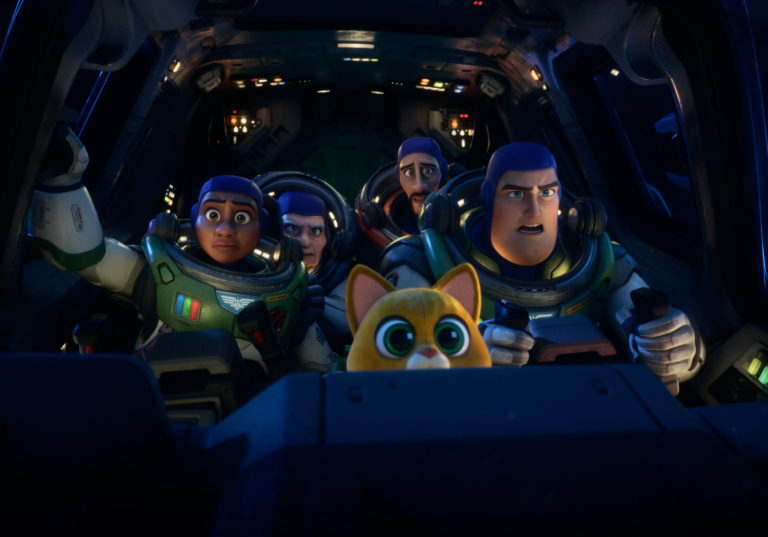Lightyear (2022 | USA | 105 minutes | Angus MacLane)
In December 2020, Pixar released a thirty-second, context-free, teaser to announce an upcoming animated film it called “the definitive story of the original Buzz Lightyear”. Although the character had been previously voiced by Tim Allen in four previous Toy Story installations, Chris Evans was taking over the vocal duties this time. As if the change of actors didn’t raise enough questions, a tweet from the new film’s star shook the very foundations of the Pixar extended universe:
And just to be clear, this isn’t Buzz Lightyear the toy.
@Chrisevans
This is the origin story of the human Buzz Lightyear that the toy is based on
What could it possibly mean?
Subsequent trailers only further deepened the mystery. Was Toy Story and its bizarre world of sentient subservient enslaved playthings who subsumed their own identities for the transient affections of an often indifferent human child actually set in our distant future? One in which intergalactic exploration had become so commonplace as not to bear mention? Where a pioneering spacefarer adventurer has inspired a line of plastic toys that spouted inane catchphrases? If the human Buzz Lightyear existed before the mass-produced action figure, there were countless things we never even thought to ask. The possibilities cracked the whole four-part trilogy (if not their whole film catalog) wide open.
The thought experiment was so much fun that I admit being kind of disappointed when Lightyear’s opening titles immediately revealed a far more straightforward explanation:
In 1995, Andy got a toy from his favorite movie …
… this is that movie.
@PixarsLightyear
As the end credits rolled on the first Pixar movie to open in theaters since the beginning of the pandemic, I found myself satisfied, smiling, and thinking: “yeah, that totally checks out.”
Upon reflection that assertion, too, requires a light suspension of disbelief. The admirable representation, diverse casting, and very-tame yet heartwarming same-sex partnership in this movie feels much more 2022 than 1995 blockbuster. The reliance of the plot on a passing familiarity with special relativity is perhaps a lot to ask of even the most sophisticated five-year-old child. But in a case of Fictional Pixar still behaving like Actual Pixar, Lightyear is definitely a movie made to win over adult audiences while still indulging the littlest kids with action, adventure, great characters, and a zippy plot.
All I’m saying is that while I’ll allow that Andy loved the space-ranging, I’ll bet whoever took him to the movie – be it a parent or teenage cousin – got more out of the sentimentality of time dilations or the mind-blowing implications of temporal paradoxes.
The film opens in the depths of space as a turnip-shaped vessel approaches an unknown world millions of light-years from Earth. Protocol leaves the civilians and scientists in their sleep pods while the brave adventurer, Buzz Lightyear, galivants onto the surface to determine whether the lushly vegetated planet is fit for human habitation. Narrating constantly into his wrist-computer, our hero is so in his own head that it takes a while for him to be reminded that he has a partner (Alisha Hawthorne, voiced by Uzo Aduba) and, much to his chagrin, is being tailed by an trainee. As the trio slowly recognize that the planet is more hostile than they anticipated, a series of hijinks, rollicking escape attempts, and Buzz’s stubbornly optimistic do-it-yourself attitude strands the whole expedition.
Given his longstanding experience portraying Captain America, the epitome of upright do-right good citizenship, one can see why Pixar cast Chris Evans. Although they share a boastful self-assurance, this human spacefarer is a more serious and grounded take than the blowhard comedic creation voiced by Tim Allen; so the change in voice immediately helps to make that distinction. This Buzz is haunted by his role in the shipwreck and is determined to do whatever’s necessary to get the mission back off the ground. Evans plays the role with a great balance of humor and as much gravitas as can be expected of a headstrong if occasionally oblivious hero.
Writer/Director Angus MacLane, a Pixar veteran taking the helm of his first feature, frames the colony’s struggles to return to space as one of a steadfast single-minded pursuit. He handily conveys the personal sacrifices required of trial-and-error experimentation through a montage that serves as a corollary to the tear-jerking opening sequence that convinced adults that Up was a great film just because it made them cry. Here, though, in place of a rich life lived, we see what Buzz is missing by doggedly returning to space while life on the ground continues without him. In a way, it’s a lot more sad, but it efficiently situates our hero as a man out of time for the bulk of the film.
Despite his preferences to the contrary (and to the benefit of the audience), Buzz isn’t entirely on his own for this quest. Lightyear adds a new first-ballot Incredibly Competent Yet Adorable Droid Hall of Famer in the form of a robot cat named Sox. Buzz’s constant companion throughout the film, the bionic kitty (voiced by Peter Sohn) is ever-present comic relief and a reliable source of resourcefulness, the likes of which the galaxy hasn’t seen since the days of R2-D2. Later, when Buzz returns from a mission to find the planet in unexpected peril, he meets up with a misfit trio of underqualified wannabe rangers Izzy (Keke Palmer) has dreams of the stars and a heroic pedigree, but a problematic fear of space; Maurice (Taika Waititi) is an ever-distracted hilarious klutz; and Darby’s (Dale Soules) a tough-talking ex-con with an air of mystery.
It’s this last half of the movie that you can imagine little Andy loving the most. The group face long odds and interpersonal conflicts while adventuring through battles with giant robots, cinematic chase sequences, close calls, and breathtaking getaways. Although they frequently stumble, each misstep sets up a little puzzle that can be overcome with a mix of bumbling, bravery, and creative problem solving. Each cycle of failure and success creates a propulsive momentum while allowing the characters enough breathing room to bond, so that by the time they’re facing the big momentous finale we’re fully invested in their success.
Unsurprisingly, with its retro-futuristic aesthetic and opportunities for stunning vistas, terrestrial and interstellar, the entire film looks great. Well-crafted details subtly mark the passage of time and the character design creates a diverse cast of distinct characters who are lifelike and human without succumbing to the discomforts of the dreaded uncanny valley. When the action hews to the cartoonish, it’s in service of a spirit of adventure that’s communicated through crisply legible action sequences. Further contributing to the sweep of the visuals is Pixar’s first foray into IMAX, with about a third of action sprawling into the full frame to communicate the inky vastness of its settings.
While the film has some adult-oriented themes – the loneliness of the frequent flier, the perils of time dilation – and some Interstellar-lite twists that might blow a tween’s mind, it isn’t a sentimental survey of the universality of the human experience. While it probably won’t make you weep, it has enough depth, reflection, and gently stirring lessons to never feel like a cheap, mass-produced toy. For my tastes, that’s fine. Instead, Lightyear aims to be the sort of crowd-pleasing summer blockbuster that might have caused a kid to set aside a well-worn cowboy in favor of a shiny new spaceman. On that front: mission accomplished.
Lightyear arrives in theaters on June 16th




